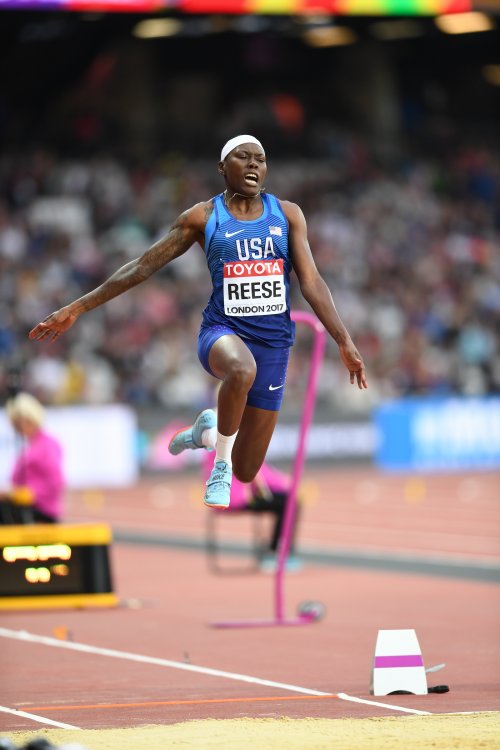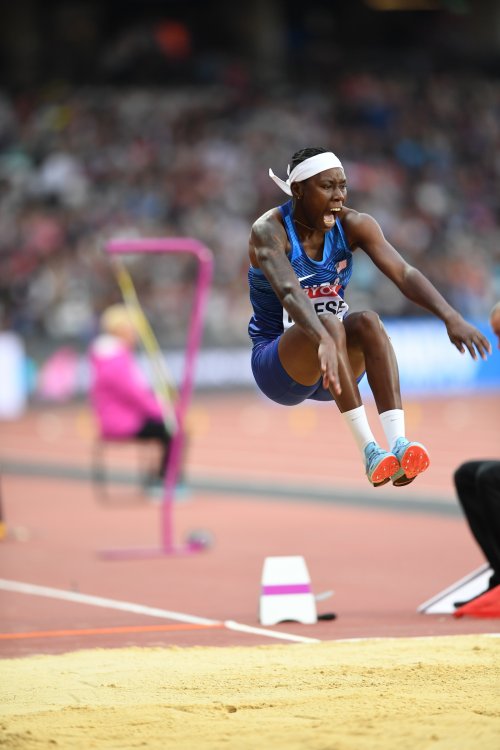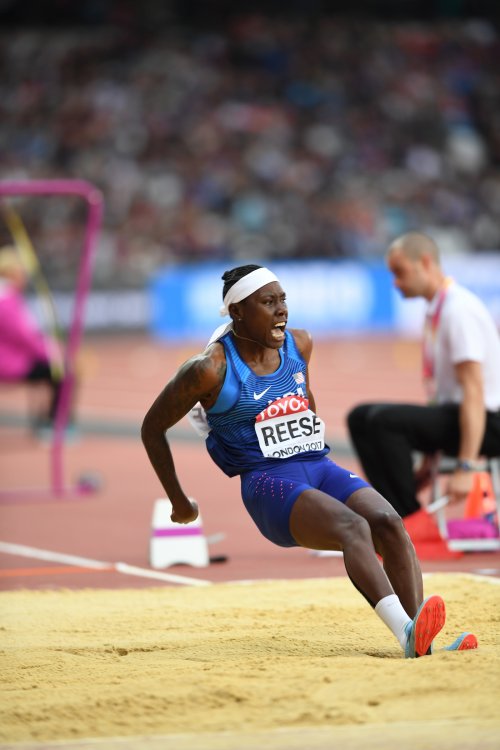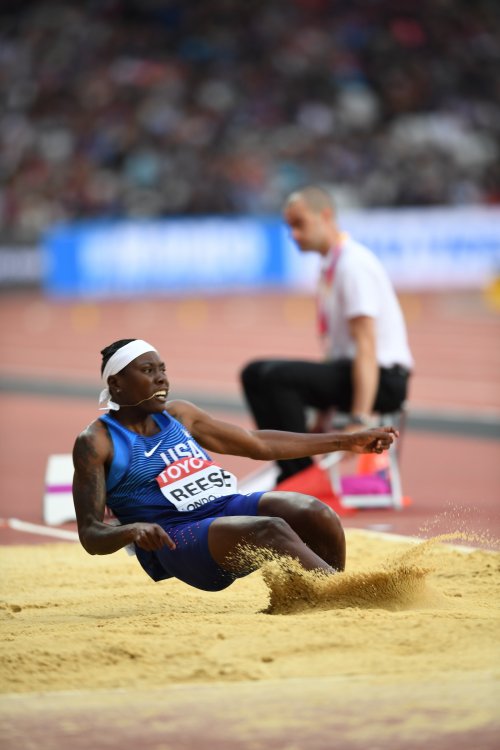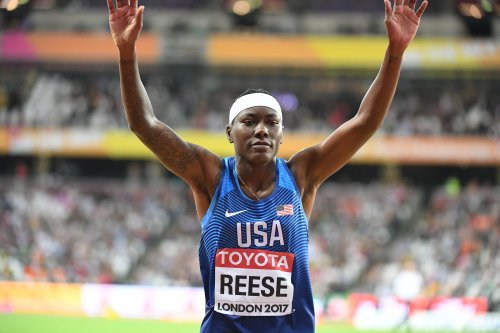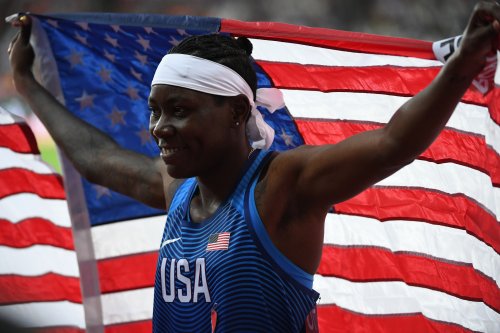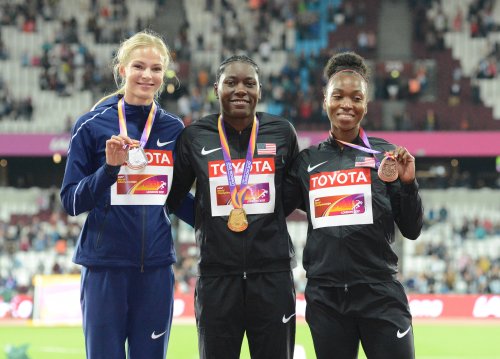Brittney Reese, London 2017, photo 1 by Martin Batemen
In my mind, Brittney Reese is the finest long jumper in American women’s track & field. Her ability to compete, her ability to draw on the experiences of her lifetime, her ability to draw the very best out of herself for 4 Olympics is outstanding. Brittney was always fun to speak with and was always a wonderful example of what is so amazing about American Track & Field. I will truly miss her. This tribute, by Stuart Weir, is obviously heartfelt. We will miss you, Brittney!
Brittney Reese
Tokyo was Brittney Reese’s fourth Olympics and her final competition – her record is 4th in 2008, winner in 2012, silver medalist in 2016 and 2020. During that period she was outdoor world champion four times and indoor world champion three times. After Tokyo she decided to call it a day – no deep philosophical debates, “I just thought it was time. I’ve been competing since 2008. I have a son and want to be around him and watch growing up. So I just thought that now would be the perfect time to let it go”.
Brittney Reese, London 2017, photo 2 by Martin Batemen
The women’s long-jump was one of the most exciting events in the Tokyo Olympics. Ese Brume took the lead in round one with 6.97. Reese also jumped in 6.97 in round 3 and was ahead due to a better second jump. Brume regained the lead in round 4 and but Reese was back in the lead in round 5. In the final round Malaika Mihambo found a 7 metre jump for gold. The top eight jumpers were at 6.80 or above and the top four beyond 6.90. Reese summed it up: “It was a nail biter all the way to the end. It was one of the toughest competitions I’ve been in, with so many women jumping over 6.80 which I don’t think has ever happened in a major championship like that. That was really good to see, although the outcome was not what I would have wanted. But I can’t be upset about the outcome given the way everything played out”.
Brittney Reese, London 2017, photo 3 by Martin Batemen
Disappointed that she could not manage a 7 metre jump – something she had achieved 27 times in her career – she explained: “Yes, when you go into a major competition, the aim is always to jump seven metres because that will normally get you the win. So every competition I go into I’m trying to get 7m. But it just didn’t happen that day”.
Brittney Reese, London 2017, photo 4 by Martin Batemen
From 2009 to 2014 she dominated the sport, winning two outdoor world championships, two indoor world and an Olympics. Recalling those days she just says with a smile: “I think I was just hungry! I thought I was the best athlete out there and I just had to go out and prove it, every time I stepped on the track. Those years were just about proving that I was the best athlete in the long jump”.
She attributes her longevity and consistency in the sport to a number of factors: “I have to give credit to the good Lord for giving me good bounce-ability and give credit to my coach for putting me in the right position to be able to jump seven metres and keeping me hungry. Also my training partners,( including Will Claye, Chris Bernard and Keturah Orji) because battling them in practice has always been helpful – they pushed me every day and motivating me in practice.
Brittney Reese, London 2017, photo 5 by Martin Batemen
“Also being smart! As I got older, I’ve learned how to train, to train smarter, not harder. Especially in the last year, I’ve only practiced three days in the week and on the other days I was recovering and resting. I’m older and I have to take more care of my body. So that’s part of the reason for my longevity and also having a great team behind me who understood what I wanted and my age and were able to put together a good plan for me and that was why I was able to be so successful for so long. Working at the training centre in Chula Vista and having everyone on the same page contributed to it”.
Brittney Reese, London 2017, photo 6 by Martin Batemen
She could have added her own work-ethic. When we talked about why she seemed to have very few fouls, she explained: “I started a new approach last year and I really tried to make sure I was mastering that approach. My new approach is only 12 steps. I shortened it but added a walk in, which helps me to get more speed quicker and helps me get my momentum quicker. When I started walking into my approach, I started coming into practice early and staying late, just working on the first couple of steps of the run-up. And I would do that 30 times a day, just working on those first two steps. I was out there before practice and after practice just making sure that I could hit it. Once I mastered it there were no fouls”.
Asked if it was true, the faster the run-up, the longer the jump. She explained further: “That’s part of it but I think body posture and the way you come off the board are just as important. But if you can get your run up right, you should be OK. During a competition, what my coach, Jeremy (Fisher) is really looking at is my posture and body position because I have a tendency to lean a bit when I get to the board”.
Darya Klishina, Brittney Reese, Tianna Bartoletta, London 2017, photo by Martin Batemen
Brittney plans to keep busy in retirement: “I have a real estate business and I have a whole bunch of things I’m trying to work on, outside of track and field. I’ve had the business since 2017. I buy houses, renovate them and sell them. I haven’t done any in the last year because of Covid but now as I’m retired I will pick it up again. I am also going to be doing some coaching and will be putting on different clinics around the world. So I’m still going to be involved in the sport, just not competing”.
Author

Caitlin Chock set the then National High School 5k Record (15:52.88) in 2004 and went on to run professionally for Nike. A freelance writer, artist, and comedian in Los Angeles, you can see more of her work on her website, Instagram and Twitter.
View all posts

